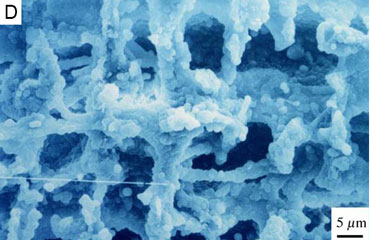Wood petrified in spring
Creationist’s rapid claims recognized






Silica filled wood tissue (C) from wood samples (F) immersed for several years in a steaming lake (A). The mineral deposits resemble those in naturally fallen wood (D) petrified at the lake’s edge (E). Opal deposits are composed of tiny spheres of silica (B).
Secular research at a hot spring in Japan shows that wood can turn into stone much faster than geologists previously thought.1
The belief that fossils and rocks petrify over millions of years is a part of modern culture—like microwave ovens and jumbo jets. We are constantly fed the idea through newspapers, magazines, museums and text books.
Like sticks of chalk in coloured water, people have absorbed the notion that fossils are millions of years old.
But the idea is false. And wrong ideas have bad consequences—sometimes serious ones.
Creation magazine often surprises readers with real examples of rocks and fossils that formed rapidly—surprises, because they contradict popular belief.
Like removing dye from a stick of chalk, it’s not easy to remove a powerful myth that colours someone’s perception of Bible history.
Recently, five Japanese scientists published more real examples of rapid petrification, confirming creationist claims.1
Even more unusual, their report to a secular geology journal quoted an article by Dr Andrew Snelling from Creation magazine.2,3The scientists, led by Hisatada Akahane, studied a small lake cradled in the explosion crater of the Tateyama Volcano in central Japan (fig. A).
A mineral-rich solution gushes from the bottom and fills the 15-m pond with steaming acidic water. It cascades over the edge as a waterfall.
The scientists found that the naturally fallen wood in the overflow was hard and heavy because it was petrified with a mineral called silica. Yet the wood was less than 36 years old.
As an experiment, they fastened pieces of fresh wood in the lake with wire. After seven years the wood had turned into stone, again petrified with silica.
Under a powerful microscope, they saw that the silica had deposited like opal, as tiny spheres smaller than the diameter of a human hair (fig. B).
It filled the pore spaces in the wood and covered the cell walls. Silica was deposited in the same way in the naturally fallen wood and in some wood found in nearby volcanic ash. Hot mineral-rich water had soaked into the spaces in every case.
Their study confirmed that under suitable conditions, wood can turn to stone in ten years or less.
This clears away one powerful objection to believing the Bible. It means that the rocks and fossils we find on the earth could easily have formed in the 4,500 years since Noah’s Flood.
And conditions would have been favourable for petrification because there was plenty of volcanic activity and mineral-rich water at the time.
‘Geologists already know petrification can happen quickly. It’s misleading to say that rapid petrification is a surprise.’
Answer: It may not be surprising to some geologists, but examples of rapid petrification are surprising to most ordinary people. Geologists often avoid mentioning how long it takes when they write about petrification, but they usually imply it was very slow. Anyway, the Japanese researchers considered it surprising.
‘The wood was still present so it was just permineralized. Petrification requires the wood itself to be replaced slowly by another mineral.’
Answer: When wood is replaced by another mineral, it is called replacement. When the mineral fills the cell spaces but does not replace the cell walls, it is called permineralization. Petrification is often used to describe both processes.
Even so, it does not need millions of years for wood cellular material to disintegrate and be replaced by mineral. All chemical processes depend simply on the chemical and physical conditions.
‘Examples of rapid petrification do not prove the world is young.’
Answer: Agreed. But they do prove that millions of years are not needed (as evolutionary articles so often imply), and so destroy a false objection to accepting biblical history.
References
- Akahane, H., et al., Rapid wood silicification in hot spring water: an explanation of silicification of wood during the Earth’s history. Sedimentary Geology 169(3–4):219–228, 15 July 2004. Return to text.
- Snelling, A.A., ‘Instant’ petrified wood, Creation 17(4):38–40, 1995; creation.com/wood. Return to text.
- Snelling, A.A., Rapid petrification of wood: an unexpected confirmation of creationist research, Impact 379, 2005. Return to text.


Readers’ comments
Comments are automatically closed 14 days after publication.